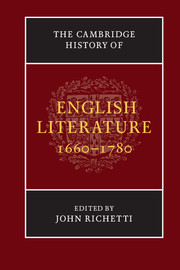Book contents
- Frontmatter
- Introduction
- PART I LITERARY PRODUCTION AND DISSEMINATION: CHANGING AUDIENCES AND EMERGING MEDIA
- 1 Publishing and bookselling 1660–1780
- 2 The social world of authorship 1660–1714
- 3 Popular entertainment and instruction, literary and dramatic: chapbooks, advice books, almanacs, ballads, farces, pantomimes, prints and shows
- 4 Novels on the market
- PART II LITERARY GENRES: ADAPTATION AND REFORMATION
- PART III LITERATURE AND INTELLECTUAL LIFE: THE PRODUCTION AND TRANSMISSION OF CULTURE
- PART IV LITERATURE AND SOCIAL AND INSTITUTIONAL CHANGE
- PART V LITERARY GENRES: TRANSFORMATION AND NEW FORMS OF EXPRESSIVENESS
- PART VI CONCLUSION
- Chronology
- Bibliographies
- Index
- References
1 - Publishing and bookselling 1660–1780
from PART I - LITERARY PRODUCTION AND DISSEMINATION: CHANGING AUDIENCES AND EMERGING MEDIA
Published online by Cambridge University Press: 28 March 2008
- Frontmatter
- Introduction
- PART I LITERARY PRODUCTION AND DISSEMINATION: CHANGING AUDIENCES AND EMERGING MEDIA
- 1 Publishing and bookselling 1660–1780
- 2 The social world of authorship 1660–1714
- 3 Popular entertainment and instruction, literary and dramatic: chapbooks, advice books, almanacs, ballads, farces, pantomimes, prints and shows
- 4 Novels on the market
- PART II LITERARY GENRES: ADAPTATION AND REFORMATION
- PART III LITERATURE AND INTELLECTUAL LIFE: THE PRODUCTION AND TRANSMISSION OF CULTURE
- PART IV LITERATURE AND SOCIAL AND INSTITUTIONAL CHANGE
- PART V LITERARY GENRES: TRANSFORMATION AND NEW FORMS OF EXPRESSIVENESS
- PART VI CONCLUSION
- Chronology
- Bibliographies
- Index
- References
Summary
The Restoration introduced remarkable changes to a book trade erratically regulated by the state but now driven by vast commercial opportunity. Escalating consumer demand spurred renewed attempts by government and the Stationers' Company to control the location and number of printing presses and the subject of publication. As the money economy deepened and prices stabilised, foodstuffs became relatively cheaper. Increased disposable income boosted the demand for non-essential and luxury goods. Prominent among the luxuries were books and print. The transformation of the literary market that followed was distinguished by bitter struggles within the trade but also by an extraordinary range of products, producers, circulation methods and literary intermediaries. During the next century the changes notably advanced the publication of religious guidebooks, novels, periodical reviews, magazines, daily, weekly and country-town newspapers, dictionaries and etiquette books. The market supported unprecedentedly famous booksellers and authors, the first library societies and commercial circulating libraries, literary reviewers, and finer distinctions between popular, polite and elite forms of literature, their suppliers and consumers.
Parliamentary renewal of the Printing Acts (also known as the licensing laws) lasted, with interruptions, until 1695, while the creation of a Licenser (superseding the Stationers' Company as a de facto censor) did not effectively outlive the appointment of Roger L'Estrange (serving from 1663 until the Revolution of 1688). Thereafter, existing legislation against libel and blasphemy offered ministers and judges last-resort controls that were also capable of extension during times of political crisis. Successive Printing Acts, restricting printing to London, Oxford, Cambridge and York, protected Stationers' Company rights and properties and thus served as a government quid quo pro for the assistance of the Company in identifying clandestine and potentially seditious printing.
- Type
- Chapter
- Information
- The Cambridge History of English Literature, 1660–1780 , pp. 11 - 36Publisher: Cambridge University PressPrint publication year: 2005
References
- 6
- Cited by



